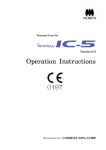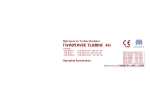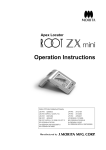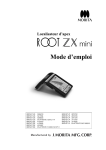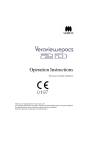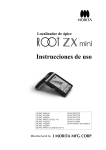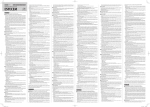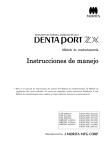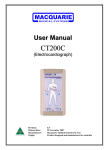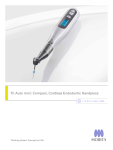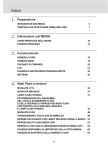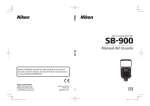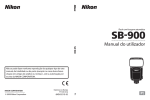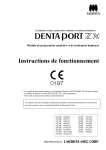Download Operation Instructions
Transcript
Apex Locator Operation Instructions US PAT. 5096419 US PAT. 5211556 US PAT. 5295833 US PAT. APPLN. 12/075, 714 DE PAT. 4126753 DE PAT. 4139424 DE PAT. 4232487 DE PAT. APPLN. 10 2008 012 677.2 JP PAT. 2873722 JP PAT. 2873725 JP PAT. 3071270 JP PAT. 3113109 JP PAT. 3113095 JP PAT. APPLN. 2007-068512 Thank you for purchasing the Root ZX mini. For optimum safety and performance, read this manual thoroughly before using the unit and pay close attention to warnings and notes. Keep this manual in a readily accessible place for quick and easy reference. This manual contains essential safety information. ATTENTION 1. J. Morita Mfg. Corp. will not be responsible for accidents, equipment damage, or bodily injury resulting from repairs made by personnel not authorized by the J. Morita Mfg. Corp. 2. J. Morita Mfg. Corp. will not be responsible for accidents, equipment damage, or bodily injury resulting from any changes, modifications, or alterations of its products. 3. J. Morita Mfg. Corp. will not be responsible for accidents, equipment damage, or bodily injury resulting from the use of products or equipment made by other manufacturers, except for those procured by the J. Morita Mfg. Corp. 4. J. Morita Mfg. Corp. will not be responsible for accidents, equipment damage, or bodily injury resulting from maintenance or repairs using parts or components other than those specified by the J. Morita Mfg. Corp. and in their original condition. 5. J. Morita Mfg. Corp. will not be responsible for accidents, equipment damage, or bodily injury resulting from operating the equipment in ways other than the operating procedures described in this manual or resulting from not following the cautionary remarks and warnings in this manual. 6. J. Morita Mfg. Corp. will not be responsible for accidents, equipment damage, or bodily injury resulting from workplace conditions and environment or installation conditions such as improper electrical power supply which do not conform to those stated in this manual. 7. J. Morita Mfg. Corp. will not be responsible for accidents, equipment damage, or bodily injury resulting from fires, earthquakes, floods, lightning, natural disasters, or acts of God. 8. J. Morita Mfg. Corp. will supply replacement parts and be able to repair the product for a period of 10 years after the manufacture of the product has been discontinued. * Inspect the unit every 6 months in accordance with the Maintenance and Inspection items. * Refer to the replacement parts lists and replace worn parts whenever necessary. Operation 2009-01-21 CONTENTS 1. Parts Identification .....................................................................................................1 2. Before Using the Unit ................................................................................................2 Connecting the Probe Cord ...................................................................................3 Checking the Function ..........................................................................................3 Checking the Function with the Tester..................................................................4 3. Operating the Unit......................................................................................................5 Operation Panel Display and Switches .................................................................5 Settings..................................................................................................................6 Meter Display........................................................................................................7 Operating the Unit.................................................................................................8 Root Canals not suitable for Electronic Measurement........................................11 Root ZX mini Meter Reading and Radiography.................................................13 4. After Using the Unit.................................................................................................14 5. Replacing Batteries ..................................................................................................15 6. Sterilization and Replacement Parts ........................................................................16 Sterilization .........................................................................................................16 Replacement Parts...............................................................................................16 Storage.................................................................................................................16 7. Maintenance and Inspection ....................................................................................17 8. Troubleshooting .......................................................................................................18 9. Technical Description ..............................................................................................20 10. Appendix- Electromagnetic declaration ..................................................................23 Operation 2009-01-21 ATTENTION CUSTOMERS Do not fail to receive clear instructions concerning the various ways to use this equipment as described in this accompanying Operator’s Manual. Fill out and sign the warranty and give the dealer from whom you purchased the equipment his copy. ATTENTION DEALERS Do not fail to give clear instructions concerning the various ways to use this equipment as described in this accompanying Operator’s Manual. After instructing the customer in the operation of the equipment, have him fill out and sign the warranty. Then fill in your own section of the warranty and give the customer his copy. Do not fail to send the manufacturer’s copy to J. Morita Mfg. Corp. Prevent Accidents Most operation and maintenance problems result from insufficient attention being paid to basic safety precautions and not being able to foresee the possibilities of accidents. Problems and accidents are best avoided by foreseeing the possibility of danger and operating the unit in accordance with the manufacturer’s recommendations. First thoroughly read all precautions and instructions pertaining to safety and accident prevention; then, operate the equipment with the utmost caution to prevent either damaging the equipment itself or causing bodily injury. Note the meaning of the following symbols and expressions: WARNING This warns that it may result serious injury of the patient or operator if the instructions are not followed properly. PROHIBITION The user can not use in such a way that may result in serious injury of the patient or operator. NOTE This alerts the user to the possibility of damage to the equipment, potential injury of the patient or operator, or important points concerning operation and performance. The user ( e.g. the hospital, clinic etc. ) is the party responsible for the maintenance and proper operation of a medical device. Medical devices must only be operated by dentists and other legally licensed professionals. Do not use this equipment for anything other than its specified purpose. Caution: Federal law restricts this device to sale by or on the order of a dentist (for U.S.A.). i Operation 2009-01-21 WARNING • This unit must not be connected to or used in combination with any other apparatus or system. It must not be used as an integral component of any other apparatus or system. J. Morita Mfg. Corp. will not be responsible for accidents, equipment damage, bodily injury or any other trouble which results from ignoring this prohibition. • Accurate canal measurement is not always possible depending on the shape and condition of the tooth as well as a decline in the equipment’s performance. • Do not use damaged file holders; an accurate measurement can not be made with a damaged file holder. • When a continuous tone is heard while the main power switch is on and without any operation, some electrical part may be malfunctioning. Do not use the unit and send the unit to J. Morita regional office for repairing. • Prescription unit. • A rubber dam should be used when performing endodontic treatment. • Check the Root ZX mini’s operation before each patient. If the indicators in the display do not all appear normally, the instrument may not be able to make an accurate measurement. In this case, stop using the instrument and have it repaired. ( see page 4 ) • Never connect the Root ZX mini to any device not approved by the J. Morita Corp. ( see page 5 ) • The meter readings 1, 2, and 3 do not correspond to any actual distance and should only be used as estimates. ( see page 5 ) • Never use the unit if the battery power indicator is flashing on and off. The unit may not function properly if the battery power is low. ( see page 5, 15 ) • The Memory Bar should only be used as an estimate. You may need to change it during enlargement and cleaning. If there seems to be some problem, stop using the instrument immediately. ( see page 6 ) • Check the settings displayed after selecting memories. ( see page 7 ) • In some cases such as a blocked canal, a measurement cannot be made. ( see page 7 ) • Always check the measurement with an x-ray. In some cases, an accurate measurement cannot be made because of the canal shape, unusual cases, or poor performance of the instrument. ( see page 7 ) • Stop using the instrument immediately if you sense something odd or abnormal while taking a measurement. ( see page 7 ) • Do not use an ultrasonic scaler with the contrary electrode attached to the patient. the scaler could interfere with canal measurements. ( see page 8 ) Electrical noise from • Make sure that the contrary electrode, file holder etc. do not come into contact with an electric power source such as an electrical socket. This could result in a severe electrical shock. ( see page 8 ) • Autoclave file holder and contrary electrode after each patient. ( see page 16 ) • Some care must be taken concerning electromagnetic compatibility (EMC) when using the Root ZX mini (hereafter referred to as the RCM-7). Refer to the user’s manual and other attached documents for EMC information regarding installation and operation. ( see page 23 ) • Both portable and movable radio frequency transmitters may have some effect on the RCM-7. ( see page 23 ) • Using replacement parts or accessories not supplied by the original manufacturer or vender could adversely affect the EMC performance of the RCM-7. ( see page 23 ) • As far as possible, do not use the RCM-7 near or simultaneously with other devices. If this cannot be avoided, observe carefully and make sure both the RCM-7 and the other device operate normally. ( see page 23 ) • Use of the parts other than those accompanied or specified by J. Morita Mfg. Corp. may result in increased EMC emissions or decreased EMC immunity of the RCM-7. ( see page 26 ) Operation 2009-01-21 ii PROHIBITION • Do not use this unit in conjunction with an electric scalpel or on patients who have a pacemaker. • Blocked canals cannot be accurately measured. • This unit must not be connected to or used in combination with any other apparatus or system. It must not be used as an integral component of any other apparatus or system. J. Morita Mfg. Corp. will not be responsible for accidents, equipment damage, bodily injury or any other trouble which results from ignoring this prohibition. • Illumination devices such as fluorescent lights and the Film viewer which use an inverter can cause the Root ZX mini to operate erratically. Do not use the Root ZX mini near devices such as these. • Electromagnetic wave interference could cause this device to operate in an abnormal, random and possibly dangerous manner. Cellular phone, transceivers, remote controls and all other devices which transmit electromagnetic waves located inside the building should be turned off. NOTE • Root ZX mini is shipped without the batteries installed. size) batteries. ( see page 2 ) Remove the cover and install the 3 LR03 (AAA • Do not reverse the plus and minus poles. ( see page 2 ) • Never allow the spring contact to push against the edge of the battery. causing a short or a leakage of battery liquid. ( see page 2 ) This could damage the outer cover • After installation, give the cover a light tug to confirm it is securely attached. ( see page 2 ) • Handle the Root ZX mini carefully; do not drop, bump or expose the unit to other kinds of impacts or shocks. Rough handling could cause damage. ( see page 3 ) • Make sure the probe cord plug is securely plugged into the jack. A poor connection can prevent measurement. ( see page 3 ) • Do not drop anything on or bang the probe cord plug after it has been inserted into the jack. ( see page 3 ) • Make sure to match colors of the file holder and contrary electrode to the probe cord. Measurements cannot be made if these connections are reversed. ( see page 3 ) • The unit may turn off if its side is bumped. ( see page 3 ) • The Flash Bar cannot be set beyond the Apex. ( see page 6 ) • The Memory Bar cannot be set beyond the Apex. ( see page 6 ) • The Memory Bar can be set at a different point for each of the 3 memories. ( see page 6 ) • The Memory Bar will stay wherever you set it until the Root ZX mini is turned off, but it will not be memorized. ( see page 6 ) • The volume of the beep that sounds when the unit is turned on cannot be adjusted. ( see page 7 ) • Do not let the file touch the gums. This will cause the meter to jump to Apex. ( see page 7 ) • If the canal is extremely dry, the meter may not move until it is quite close to the apex. not move, try moistening the canal with oxydol or saline. ( see page 7 ) If the meter does • Occasionally the canal length indicator bar will make a sudden and large movement as soon as the file is inserted into the root canal, but it will return to normal as the file is advanced down towards the apex. ( see page 7 ) • The contrary electrode could cause an adverse reaction if the patient has an allergy to metals. patient about this before using the contrary electrode. ( see page 8 ) Ask the • Take care that medicinal solutions such as formalin cresol (FC) or sodium hypochlorite do not get on the contrary electrode or the file holder. These could cause an adverse reaction such as inflammation. ( see page 8 ) • Always clip the file holder to the upper part of file shaft, near the handle. The metal and plastic part of the file holder can be damaged if they are attached to the file’s cutting part or the transition to the cutting part. ( see page 9 ) • Use files and reamers with plastic handles only. If the file has a metal handle, electrical leakage will occur when the handle is touched by fingers and it will prevent an accurate root canal measurement. Even if the file handle is made of plastic, make sure not to touch the metal part of the file with finger. ( see page 9 ) iii Operation 2009-01-21 NOTE • Do not use damaged file holders. ( see page 9 ) An accurate measurement cannot be made using a damaged file holder. • Clip the file as shown in illustration right. If the file is in the position illustration #2, it may not make measurement and the file holder damaged. ( see page 9 ) GOOD BAD #1 to the shown in a correct could be 1 • Make sure to take an x-ray to check the results. ( see page 10 ) • Do not pull directly on the cords when connecting or disconnecting the probe and file holder. Always grip the connectors to connect and disconnect cords. ( see page 14 ) 2 BAD BAD • Do not wrap the probe cord around the body of the main unit. ( see page 14 ) • Do not reverse the plus and minus poles. ( see page 15 ) Cord • Never allow the spring contact to push against the edge of the battery. This could damage the outer cover causing a short or a leakage of battery liquid. ( see page 15 ) • After installation, give the cover a light tug to confirm it is securely attached. ( see page 15 ) • Always use LR03 alkaline, oxyride, or manganese dry cells. (Manganese dry cells will not last as long as oxyride or alkaline dry cells.) Never use rechargeable nickel-hydrogen or nickel-cadmium batteries. ( see page 15 ) • All the dry cells should be of the same type: i.e., all alkaline, all OxyrideTM , or all manganese. ( see page 15 ) • Replace all three batteries at the same time. ( see page 15 ) • Never use batteries that are leaky, deformed, discolored or otherwise abnormal. ( see page 15 ) • Dispose of old batteries according to local codes and regulations. ( see page 15 ) • In case of battery leakage, carefully dry the battery terminals and remove all of the leaked liquid. the battery with a new one. ( see page 15 ) Replace • Do not sterilize in any way other than autoclave. ( see page 16 ) • Autoclave and dry at 135°C, but do not exceed that temperature. ( see page 16 ) • The file holder and contrary electrode must be thoroughly washed and cleaned before autoclaving. ( see page 16 ) • Any chemicals or foreign debris left on instruments could cause them to malfunction or could cause discoloration. ( see page 16 ) • It is highly recommended that instruments be autoclaved in a sterilization pouch (wrapped) or similar device. ( see page 16 ) • Do not autoclave probe cord. • Follow the manufacturer’s recommendations to disinfect files. ( see page 16 ) • Do not wipe the surface of the main unit and probe cord with any type of alcohol except disinfecting ethanol (80 vol%). Any other type of solution could cause cracking, cloudiness, discoloration or some similar kind of damage. ( see page 16 ) • Do not get the box too wet with ethanol; it could seep inside and cause a malfunction. * Be especially careful when cleaning around the port for data output and the jack for the probe cord. ( see page 16 ) • On rare occasions, static electricity produced by wiping the liquid crystal display with a dry cloth may have some influence on the appearance of the display. ( see page 16 ) • Avoid spilling chemical solutions used for treatment on the Root ZX mini. These chemicals could cause damage, deform or discolor the Root ZX mini. Be especially careful to avoid spilling formalin cresol (FC) and sodium hypochlorite as they are quite strong. Wipe up any chemical spills immediately. (Some chemicals may leave discoloration and spots even if they are immediately wiped up.) ( see page 16 ) Operation 2009-01-21 iv 1. Parts Identification Intended use This unit can be used to detect the apex of root canal. LCD Screen File Holder Contrary Electrode Set Switch Power Switch Strap Holes Probe Cord Data Output Port (to transmit display data) Accessories Probe Cord (1) File Holder (3) Contrary Electrode (5) Tester (1) Alkaline Dry Cells (3) Long File Holder (Option) (LR03 (AAA size) batteries) 1 Operation 2009-01-21 2. Before Using the Unit NOTE Root ZX mini is shipped without the batteries installed. Remove the cover and install the 3 LR03 (AAA size) batteries. Installing the Batteries 1. Slide the cover in the direction by the arrow in the illustration and remove it from the ROOT ZX mini. 2. Insert the 3 LR03 (AAA size) batteries included in the package. (1) Insert the batteries by first pressing center of the minus end against its spring contact. (2) Slide the plus end down into place and make sure the contacts are not bent or damaged. NOTE BAD • Do not reverse the plus and minus poles. • Never allow the spring contact to push against the edge of the battery. This could damage the outer cover causing a short or a leakage of battery liquid. 3. Slide the cover all the way down until it is securely closed. NOTE After installation, give the cover a light tug to confirm it is securely attached. Operation 2009-01-21 2 Connecting the Probe Cord 1. Insert the probe cord completely into the jack on the left side of the Root ZX mini. NOTE • Handle the Root ZX mini carefully; do not drop, bump or expose the unit to other kinds of impacts or shocks. Rough handling could cause damage. • Make sure the probe cord plug is securely plugged into the jack. A poor connection can prevent measurement. • Do not drop anything on or bang the probe cord plug after it has been inserted into the jack. 2. Insert the file holder’s gray male plug into the gray female connector on the probe cord. Insert the contrary electrode into the white female connector on the probe cord. Probe Cord Connector (white) Contrary Electrode File Holder Plug Probe Cord Connector (gray) NOTE Make sure to match colors of the file holder and contrary electrode to the probe cord. Measurements cannot be made if these connections are reversed. Checking the Function 1. Press the Power switch to turn the unit on. will appear in the LCD screen. The display * The instrument turns itself off if it is not used for 10 minutes. NOTE The unit may turn off if its side is bumped. Contrary Electrode 2. Check that the probe cord is properly plugged into the jack. File Holder Contact 3. Check that the file holder and contrary electrode are properly connected to the probe cord. 4. Touch the metal part of the file holder with the contrary electrode. Check that all the meter indicator bars on the display light up. 3 Operation 2009-01-21 WARNING Check the Root ZX mini’s operation before each patient. If the indicators in the display do not all appear normally, the instrument may not be able to make an accurate measurement. In this case, stop using the instrument and have it repaired. Checking the Function with the Tester Check Root ZX mini’s performance with the tester once a week. 1. Press the Power switch to turn the unit on. 2. Insert the tester into the probe cord jack. Check that the meter indicates within ±3 bars away from (above or below) 1. Tester * The meter may jump when the tester is inserted. If it does, wait for about one second until the meter stabilizes and then check the reading. * If the reading is 4 or more bars away from 1, the unit will not make an accurate measurement. In this case, contact your local dealer or J. Morita regional office. Must be within this range Operation 2009-01-21 4 3. Operating the Unit WARNING Never connect the Root ZX mini to any device not approved by the J. Morita Corp. Operation Panel Display and Switches Sound Volume Off, Low, High Battery Power Indicator This bar graph indicates remaining battery power. Replace the batteries when this indicator begins flashing. Canal Length Indicator Bars WARNING Never use the unit if the battery power indicator is flashing on and off. The unit may not function properly if the battery power is low. Meter WARNING The meter readings 1, 2, and 3 do not correspond to any actual distance and should only be used as estimates. * When battery power falls too much, alarm will sound and the unit will automatically turn itself off. * The unit will automatically turn off after 10 minutes of non-use. Power Switch Set Switch Information Display ▪ Standby (file outside canal): Memory Number for Flash Bar ▪ During Measurement (file inside canal): Number of bars left before Flash Bar is reached ▪ When Flash Bar position is being set: Position of Flash Bar Flash Bar Use this line as an estimate for root canal measurement. Memory Bar Use this as an estimate of some intermediate point inside the canal. 5 Operation 2009-01-21 Settings 1. Select Memorized Flash Bar Method Press Set Switch. Each press of the Set Switch will change the memory selected in the sequence 01 to 02 to 03 and then back to 01 again. The Flash Bar set for each memory will appear when that memory is selected. The memory selected when the unit is turned off is the one that will be selected when is it turned back on again. 2. Set the Flash Bar Flashes The Flash Bar can be set anywhere from 2 to Apex (0). Use it as an estimate of the canal’s working length. Method When the file is not inserted, hold down the Power Switch and then press the Set Switch at the same time. Each press of the Set Switch will move the Flash Bar one bar towards the Apex. The position will be automatically memorized. NOTE The Flash Bar cannot be set beyond the Apex. 3. Memory Bar File position The Memory Bar can be set anywhere up to APEX. The Memory Bar can be set during treatment to mark a point of interest inside the canal such as the beginning of a curve, a certain distance from the apex, or the point to change file size for enlargement. Method Insert the file up to the desired point and then press the Set Switch. This will cause another bar to flash on and off at a slightly slower speed that the main Flash Bar. This will not change the point where the alarm is activated. WARNING The Memory Bar should only be used as an estimate. You may need to change it during enlargement and cleaning. If there seems to be some problem, stop using the instrument immediately. Memory Bar starts flashing NOTE • The Memory Bar cannot be set beyond the Apex. • The Memory Bar can be set at a different point for each of the 3 memories. • The Memory Bar will stay wherever you set it until the Root ZX mini is turned off, but it will not be memorized. Operation 2009-01-21 6 4. Beeper Volume The volume of the beep can be set for Loud or Soft, or it can be turned off. Method Hold down the Set Switch and turn the Root ZX mini on. This will change the setting of the beep from Loud to Off. Repeat the procedure to change it from Off to Soft. The setting will be memorized and stay the same the next time you turn the unit on. NOTE The volume of the beep that sounds when the unit is turned on cannot be adjusted. WARNING Check the settings displayed after selecting memories. Meter Display ■ The position of the file tip is shown by the canal length indicator bar on the display. The Flash Bar flashes on and off once file is inserted into the root canal. NOTE Flashes • Do not let the file touch the gums. This will cause the meter to jump to Apex. • If the canal is extremely dry, the meter may not move until it is quite close to the apex. If the meter does not move, try moistening the canal with oxydol or saline. • Occasionally the canal length indicator bar will make a sudden and large movement as soon as the file is inserted into the root canal, but it will return to normal as the file is advanced down towards the apex. WARNING • In some cases such as a blocked canal, a measurement cannot be made. (For details “Root Canals not suitable for Electronic Measurement.”) • Always check the measurement with an x-ray. In some cases, an accurate measurement cannot be made because of the canal shape, unusual cases, or poor performance of the instrument. • Stop using the instrument immediately if you sense something odd or abnormal while taking a measurement. 7 Operation 2009-01-21 ■ The meter’s 0.5 reading indicates that the tip of the file is in or very near the apical constriction. * The numerals on the meter gauge do not represent millimeters. Flashes ■ If the file tip reaches the apical foramen, a single, sustained beep will sound, and the word "APEX" and the little triangle next to the Flash Bar will start to flash on and off. Flashes Operating the Unit 1. Turn the unit on. 2. Hook the contrary electrode in the corner of the patient's mouth. WARNING Contrary Electrode • Do not use an ultrasonic scaler with the contrary electrode attached to the patient. Electrical noise from the scaler could interfere with canal measurements. • Make sure that the contrary electrode, file holder etc. do not come into contact with an electric power source such as an electrical socket. This could result in a severe electrical shock. NOTE • The contrary electrode could cause an adverse reaction if the patient has an allergy to metals. Ask the patient about this before using the contrary electrode. • Take care that medicinal solutions such as formalin cresol (FC) or sodium hypochlorite do not get on the contrary electrode or the file holder. These could cause an adverse reaction such as inflammation. Operation 2009-01-21 8 Press 3. Clip the file holder to the metal shaft of the file. (1) Press in direction of arrow with the thumb. (2) Clip file. (3) Release thumb. File Holder File or Reamer NOTE Handle Metal part of file holder Cutting part and transition to cutting part Do not clip onto this part! Always clip the file holder to the upper part of file shaft, near the handle. The metal and plastic part of the file holder can be damaged if they are attached to the file’s cutting part or the transition to the cutting part. GOOD NOTE 1 BAD • Use files and reamers with plastic handles only. If the file has a metal handle, electrical leakage will occur when the handle is touched by fingers and it will prevent an accurate root canal measurement. Even if the file handle is made of plastic, make sure not to touch the metal part of the file with finger. • Do not use damaged file holders. An accurate measurement cannot be made using a damaged file holder. • Clip the file as shown in illustration #1 to the left. If the file is in the position shown in illustration #2, it may not make a correct measurement and the file holder could be damaged. 2 9 Operation 2009-01-21 4. Press the Set Switch to select Memory 01, 02 or 03. Set Switch 5. Insert the file up to the Flash Bar (this point can also be recognized by the change in the beeping). Position the rubber stopper on the tooth surface as a reference point to determine the root canal’s working length. Use the 0.5 reading on the meter to estimate the canal’s length. Flash Bar 6. Determine the working length. File Holder ■ If the file tip is at the 0.5 meter reading, subtract from 0.5 to 1.0 mm to determine the working length. 0.5 Reading * The working length will differ somewhat depending on each individual tooth. This discrepancy must be judged by the dentist as he works on the tooth. Rubber Stopper NOTE Make sure to take an x-ray to check the results. Operation 2009-01-21 10 Root Canals not suitable for Electronic Measurement Accurate measurement cannot be obtained with the root canal conditions shown below. There may be cases other than these where an accurate measurement cannot be made. Root Canal with a large apical foramen Root canal that has an exceptionally large apical foramen due to a lesion or incomplete development cannot be accurately measured; the results will show shorter measurement than the actual length. Clean Root Canal with blood, saliva or a chemical solution overflowing from the opening If blood, saliva, or a chemical solution overflows from the opening of the root canal and contacts the gums, this will result in electrical leakage and an accurate measurement cannot be obtained. Wait for bleeding to stop completely. Clean the inside and opening of the canal thoroughly to get rid of all blood, saliva and chemical solutions and then make a measurement. Broken crown If the crown is broken and a section of the gingival tissue intrudes into the cavity surrounding the canal opening, contact between the gingival tissue and the file will result in electrical leakage and an accurate measurement cannot be obtained. In this case, build up the tooth with a suitable material to insulate the gingival tissue. Build-up Fracture Fractured tooth Leakage through a branch canal Fractured tooth will cause electrical leakage and an accurate measurement cannot be obtained. A branch canal will also cause electrical leakage. Branch Re-treatment of a root filled with gutta-percha The gutta percha must be completely removed to eliminate its insulating effect. After removing the gutta percha, pass a small file all the way through the apical foramen and then put a little saline in the canal, but do not let it overflow the canal opening. Gutta-Percha 11 Operation 2009-01-21 Crown Crown or metal prosthesis touching gingival tissue Accurate measurement cannot be obtained if the file touches a metal prosthesis that is touching gingival tissue. In this case, widen the opening at the top of the crown so that the file will not touch the metal prosthesis before taking a measurement. Debris Cutting debris on tooth Pulp inside canal Thoroughly remove all cutting debris on the tooth. Thoroughly remove all the pulp inside the canal; otherwise an accurate measurement cannot be made. Pulp Caries touches gums Caries touching the gums In this case, electrical leakage through the caries infected area to the gums will make it impossible to obtain an accurate measurement. Blocked Canal The meter will not move if the canal is blocked. Open the canal all the way to the apical constriction to measure it. Blocked Extremely dry canal If the canal is extremely dry, the meter may not move until it is quite close to the apex. In this case, try moistening the canal with oxydol or saline. Too Dry Operation 2009-01-21 12 Root ZX mini Meter Reading and Radiography Sometimes the Root ZX mini meter reading and the x-ray image will not correspond. This does not mean that the Root ZX mini is not working properly or that the x-ray exposure is a failure. * Occasionally, the actual apical foramen does not correspond exactly. The actual apical foramen may be located up towards the crown. In these cases, the x-ray image will seem to indicate that the file has not reached the apex. X-ray Tube X-ray Film Apical foramen is located up towards the crown. * Depending on the angle of penetration of the x-ray beam, the apex may not appear correctly, and the position of the apical foramen may appear to be located differently than it actually is. 13 Operation 2009-01-21 4. After Using the Unit 1. Turn the unit off. * The unit will automatically turn off after 10 minutes of non-use. 2. Disconnect the probe cord and other cords or cables. NOTE BAD BAD Cord Always grip the connectors to connect and disconnect cords. Operation 2009-01-21 • Do not pull directly on the cords when connecting or disconnecting the probe and file holder. Always grip the connectors to connect and disconnect cords. • Do not wrap the probe cord around the body of the main unit. 14 5. Replacing Batteries Replace the batteries as soon as the battery power indicator starts flashing. WARNING Never use the unit if the battery power indicator is flashing on and off. The unit may not function properly if the battery power is low. * When battery power falls too much, an alarm will sound and the unit will automatically turn itself off. 1. Slide the cover in the direction by the arrow in the illustration and remove it from the Root ZX mini. 2. Insert the 3 LR03 (AAA size) batteries included in the package. (1) Insert the batteries by first pressing center of the minus end against its spring contact. (2) Slide the plus end down into place and make sure the contacts are not bent or damaged. NOTE BAD • Do not reverse the plus and minus poles. • Never allow the spring contact to push against the edge of the battery. This could damage the outer cover causing a short or a leakage of battery liquid. 3. Slide the cover all the way down until it is securely closed. NOTE • After installation, give the cover a light tug to confirm it is securely attached. • Always use LR03 alkaline, OxyrideTM , or manganese dry cells. (Manganese dry cells will not last as long as OxyrideTM or alkaline dry cells.) Never use rechargeable nickel-hydrogen or nickel-cadmium batteries. • All the dry cells should be of the same type: i.e., all alkaline, all OxyrideTM , or all manganese. • Replace all three batteries at the same time. • Never use batteries that are leaky, deformed, discolored or otherwise abnormal. • Dispose of old batteries according to local codes and regulations. • In case of battery leakage, carefully dry the battery terminals and remove all of the leaked liquid. Replace the battery with a new one. * Overheating or malfunctions could result if the above conditions are not adhered to. * The three LR03 alkaline dry cells used for this unit will last for about 70 hours of use. (This equals 6 to 12 months at the normal rate of usage.) 15 Operation 2009-01-21 6. Sterilization and Replacement Parts Sterilization a. Autoclavable Components [File Holder and Contrary Electrode] Recommended temperature and time: 135°C (275°F), 6 minutes minimum with a sterilization pouch. Minimum drying time after sterilization: 10 minutes. WARNING Autoclave file holder and contrary electrode after each patient. NOTE • • • • Do not sterilize in any way other than autoclave. Autoclave and dry at 135°C, but do not exceed that temperature. The file holder and contrary electrode must be thoroughly washed and cleaned before autoclaving. Any chemicals or foreign debris left on instruments could cause them to malfunction or could cause discoloration. • It is highly recommended that instruments be autoclaved in a sterilization pouch (wrapped) or similar device. • Do not autoclave probe cord. • Follow the manufacturer’s recommendations to disinfect files. b. Sterilize Surface of Main Unit and Probe Cord with Ethanol * Wipe with a piece of gauze dampened with ethanol (80 vol%). Wring the gauze out to make sure it is not too wet. NOTE • Do not wipe the surface of the main unit and probe cord with any type of alcohol except disinfecting ethanol (80 vol%). Any other type of solution could cause cracking, cloudiness, discoloration or some similar kind of damage. • Do not get the box too wet with ethanol; it could seep inside and cause a malfunction. * Be especially careful when cleaning around the port for data output and the jack for the probe cord. • On rare occasions, static electricity produced by wiping the liquid crystal display with a dry cloth may have some influence on the appearance of the display. • Avoid spilling chemical solutions used for treatment on the Root ZX mini. These chemicals could cause damage, deform or discolor the Root ZX mini. Be especially careful to avoid spilling formalin cresol (FC) and sodium hypochlorite as they are quite strong. Wipe up any chemical spills immediately. (Some chemicals may leave discoloration and spots even if they are immediately wiped up.) Replacement Parts * Replace parts as necessary depending on degree of wear and length of use. * Order replacement parts from your local dealer or J. Morita regional office. Storage * Store the unit where it will not be exposed to x-rays or direct sunlight and where the ambient temperature range is between -10°C / 14°F and 70°C / 158°F ; humidity between 8 RH and 80 RH % (without condensation) and atmospheric pressure between 700 hPa and 1,060 hPa. * If the unit has not been used for a long time, make sure it works properly before use. * Always remove the batteries prior to storing or shipping the unit. * The working-life of this unit is 6 years from the date of shipment provided it is regularly and properly inspected and maintained. Operation 2009-01-21 16 7. Maintenance and Inspection The user (hospital, medical institute or clinic) is responsible for inspection and maintenance of medical units. Regular Inspection * This unit should be inspected every 6 months in accordance with the following maintenance and inspection items. Maintenance and Inspection Items 1. Check that the Power switch turns the unit on and off properly. 2. Insert the Tester and check that the indicator is within ±3 lines of 1 on the meter. 3. Check that the Set switch changes the memory from 01 to 02 to 03. 4. Check that the probe cord can be properly plugged into its jack. 5. Check that the file holder's plug can be connected properly to the probe cord and that the file holder can be clipped onto a file. Check the contrary electrode can be plugged into its probe cord connector. 6. Touch the contrary electrode with the file holder and make sure all the bars on the meter light up. 7. This unit should be inspected after prolonged unusual period. Parts Lists Probe Cord Code No. 8449422 Tester Code No. 8449430 File Holder Code No. 7503670 Contrary Electrode Code No. 7503680 Long File Holder Code No. 7503673 17 Operation 2009-01-21 8. Troubleshooting If the unit does not seem to be working properly, the user should first try to inspect and adjust it himself. * If the user is unable to inspect the instrument himself or if the instrument fails to work properly after being adjusted or after parts are replaced, contact the J. Morita Corp. or your local dealer. Problem Check Points Response Check battery installation. Install batteries properly. Check battery power. Replace batteries. Check cord connections. Check that all connections are properly secured. Check probe cord for broken wire. Touch the contrary electrode to the file holder to check probe cord conductivity. No alarm sound. Check if sound is turned off. Turn the sound on. Cannot switch memories. Is a measurement being performed? The memory cannot be changed while the unit is making a measurement. Cannot change memory settings. Does the switch work? Switch may be broken. Display does not appear. Try replacing the dry cells. If new dry cells do not solve the problem, the LCD may be malfunctioning. Is contrary electrode making good contact with oral mucosa? Make sure the contrary electrode makes good contact with the oral mucosa. No power Cannot make a Measurement. Canal Length Indicator is unstable. Is the file holder dirty? Canal Length Indicator overreacts or is too sensitive. (Measurements are too short. Poor accuracy. Erratic results.) Operation 2009-01-21 Clean the file holder with Ethanol for Disinfection (Ethanol 80 vol%). Is blood or saliva overflowing from the opening of the crown? If blood or other fluids overflow the canal, the current will leak to the gums and the meter will jump to Apex. Clean the canal, canal opening and tooth crown thoroughly. Is the canal filled with blood, saliva or chemical solutions? The canal length indicator bar may suddenly swing when it breaks the surface of fluids inside the canal, but it will return to normal as the file is advanced down toward the apex. Is the tooth surface covered with cutting debris or chemical solutions? Clean entire tooth surface. Is the file touching the gingival tissue? This will cause the canal length indicator bar to suddenly jump all the way to the “APEX”. Is there pulp tissue left inside the root canal? Accurate measurements cannot be obtained if a large amount of pulp tissue is left inside the root canal. Is the file touching a metal prosthesis? Touching a metal prosthesis with the file allows a flow of current to the gingival tissue or periodontal pocket and will cause the meter to jump to the “APEX”. Are proximal surfaces infected with caries? Current can flow through the caries infected area to the gums and prevent an accurate measurement from being made. 18 Problem Canal Length Indicator overreacts or is too sensitive. (Measurements are too short, poor accuracy or erratic results.) Canal Length Indicator does not move at all or only when the file tip is close to the apical foramen. Cannot set Memory Bar for file tip at desired point. Check Points Response Are there lateral canals or is the The canal length indicator bar may jump to tooth fractured? “APEX” when it reaches the opening of a lateral canal or the opening of a fractured tooth that allows the current to flow to the gingival tissue. Does a broken crown leakage of electric current? allow Build up an insulating barrier to stop the leakage. Is there a lesion at the apex? A lesion can destroy the apical foramen through absorption and an accurate measurement cannot be obtained. Is the file holder broken or dirty? Replace or clean the file holder. Is the canal blocked? Open the passage all the way through the apical constriction first and then take the measurement. Is the apical foramen very large If the apical foramen is large or wide open and not completely formed, the canal length and open? indicator bar will suddenly jump when the file tip gets close to the apex. Is the canal extremely dry? Moisten the canal with oxydol or a saline solution. Is desired indicator bar lit up? Advance file to desired point. Did you press the Set switch? Press Set switch firmly. Has file tip gone beyond Apex Bar? Move file tip up above the Apex Bar. Warranty 1 Year Limited Warranty 1. The manufacturer gives a guarantee for one year beginning from the date of purchase. Within this period any defect that is due to faulty manufacturing or material will be remedied by repair or replacement at the judgment of the manufacturer or its distributor. 2. Warranty repair and service: In the event of a claim under this guarantee, the device is to be sent to the service facility of the distributor, postage and shipping paid, including a short description of the problem, and a copy of the sales receipt from the dealer as proof of purchase and title to warranty. Always ship prepaid. Distributor does not accept collect shipments. 3. In the case of damage caused by wear and tear, careless handling and repairs not carried out by an authorized service facility, the warranty ceases to be valid. This guarantee may not form the basis for any claims for damages, in particular not for compensation of consequential damages. The buyer assumes responsibility for damage due to dropping of the unit, improper use and utilization of product and chemicals other than those stated in this instruction manual for cleaning. It is the customer’s responsibility to maintain the exact rated voltage indicated at the bottom of the unit, and the office maintains electrical outlets for proper performance of the unit. 4. This warranty does not include the external accessories, file electrode, batteries, or transportation costs. 19 Operation 2009-01-21 9. Technical Description Main unit and accessories Model RCM-7 Classification Safety according to IEC 60601-1, IEC 60601-1-2, UL60601-1, CAN/CSA C22.2 NO.601.1-M90 European Directive 93/42/EEC IIa Canada Medical devices Class II Type of Protection against Electric Shock Battery operated Degree of Protection against Electric Shock Type BF applied part Degree of Protection (IEC 60529 ) IPX O Mode of Operation Continuous Main unit Power Supply DC 4.5 V (three alkaline dry cells (LR03 (AAA size) batteries)) Power Rating 0.2 W Measurement Voltage AC 80 mV, maximum Measurement Current 10 μA, maximum Display Reflective Color LCD Piezoelectric Beeper Dimensions Approx. 60 (mm) × 103 (mm) × 57 (mm) Weight Approx. 110 (g) Operation, Transport and Storage Conditions for the main unit Operating Conditions Ambient temperature range +10° / 50° F ~ +40° C / 104° F Relative humidity 30 ~ 80 RH % without condensation Atmospheric pressure range 800~ 1,060 hPa Transport and Storage Conditions Ambient temperature range -10° / 14° F ~ +70° C / 158° F Relative humidity 8 ~ 80 RH % without condensation Atmospheric pressure range 700 ~ 1,060 hPa Operation 2009-01-21 20 Symbols Labels The Root ZX mini conforms with the European Directive, 93 / 42 / EEC which includes the requirements for electromagnetic compatibility. Attention, consult accompanying documents. Serial Number [Example of Serial Number] SN O A 0 0 0 1 Year of Manufacture Month of Manufacture Lot No. U V W X A B C D 0001 : : : : 2006 2007 2008 2009 : Jan. : Feb. : March : April L : Dec. Manufacturer This symbol is affixed to fulfill the requirements of EU Directive 2002/92/ED Article 11. This equipment cannot be disposed of as unsorted municipal waste within the European Union. Follow local regulations for disposal. cTUVus certification mark for the U.S. and Canadian (U.S., Canada) Type BF applied part (Contrary Electrode and File Holder) 21 Operation 2009-01-21 Operation Instructions Authorized representative in the European Community Package Temperature Limitation Battery This symbol is affixed to fulfill the requirements of EU Directive 2006/66/EC Article 21. Batteries provided with this equipment cannot be disposed of as unsorted municipal waste within the European Union. Follow local regulations for disposal. Disposal The battery should be recycled*. Metal parts of the equipment are disposed as scrap metal. Synthetic materials, electrical components, and printed circuit boards are disposed as electrical scrap. Material must be disposed according to the relevant national legal regulations. Consult specialized disposal companies for this purpose. Please inquire of the local administration concerning local disposal companies. * For disposal of batteries in EU countries, refer to the above remarks concerning batteries. Inquire with the local dealer where the batteries or equipment were purchased for details concerning battery disposal. Service Root ZX mini may be repaired and serviced by • The technicians of J. Morita’s subsidiaries all over the world. • Technicians employed by authorized J. Morita dealers and specially trained by J. Morita. • Independent technicians specially trained and authorized by J. Morita. Operation 2009-01-21 22 10. Appendix- Electromagnetic declaration WARNING • Some care must be taken concerning electromagnetic compatibility (EMC) when using the Root ZX mini (hereafter referred to as the RCM-7). Refer to the user’s manual and other attached documents for EMC information regarding installation and operation. • Both portable and movable radio frequency transmitters may have some effect on the RCM-7. • Using replacement parts or accessories not supplied by the original manufacturer or vender could adversely affect the EMC performance of the RCM-7. • As far as possible, do not use the RCM-7 near or simultaneously with other devices. If this cannot be avoided, observe carefully and make sure both the RCM-7 and the other device operate normally. Guidance and manufacturer’s declaration – electromagnetic emissions The RCM-7 is intended for use in the electromagnetic environment specified below. The customer or the user of the RCM-7 should assure that it is used in such an environment. Emissions test Compliance RF emissions CISPR 11 Group 1 RF emissions CISPR 11 Class B Harmonic emissions IEC61000-3-2 Not applicable Voltage fluctuations/flicker emissions IEC 61000-3-3 Not applicable Electromagnetic environment - guidance The RCM-7 uses RF energy only for its internal function. Therefore, its RF emissions are very low and are not likely to cause any interference in nearby electronic equipment. The RCM-7 is suitable for use in all establishments, including domestic establishments and those directly connected to the public low-voltage power supply network that supplies buildings used for domestic purposes. 23 Operation 2009-01-21 Guidance and manufacturer’s declaration – electromagnetic immunity The RCM-7 is intended for use in the electromagnetic environment specified below. The customer or the user of the RCM-7 should assure that it is used in such an environment. IEC 60601 test level Immunity test Compliance level Electrostatic discharge (ESD) IEC 61000-4-2 +6 kV contact +2, 4, 6 kV contact +8 kV air +2, 4, 8 kV air Electrical fast transients/bursts IEC 61000-4-4 +2 kV for power supply lines +1 kV for input/output lines +1 kV line(s) to line(s) +2 kV line(s) to earth Not applicable <5% UT (>95% dip in UT) for 0.5 cycle Not applicable 40% UT (60% dip in UT ) for 5 cycles Not applicable 70% UT (30% dip in UT ) for 25 cycles Not applicable <5% UT (>95% dip in UT) for 5 sec Not applicable 3 A/m 3.15 A/m Surge IEC 61000-4-5 Voltage dips, short interruptions and voltage variations on power supply lines IEC 61000-4-11 Power frequency (50/60 Hz) magnetic field IEC 61000-4-8 Not applicable Not applicable Electromagnetic environment guidance Floors should be wood, concrete or ceramic tile. If floors are covered with synthetic material, the relative humidity should be at least 30 %. The test is applicable since the EUT does not have AC/DC power ports and signal / interconnecting cable longer than 3m. The test is not applicable since the EUT does not have AC power port. Not applicable The test is not applicable since the EUT does not have AC power port. Power frequency magnetic field should be at levels characteristic of a typical location in a typical commercial or hospital environment. Note UT is the a.c. mains voltage prior to application of the test level. Operation 2009-01-21 24 Guidance and manufacturer’s declaration – electromagnetic immunity The RCM-7 is intended for use in the electromagnetic environment specified below. The customer or the user of the RCM-7 should assure that it is used in such an environment. Immunity test IEC 60601 test level Compliance level Electromagnetic environment - guidance Portable and mobile RF communications equipment should be used no closer to any part of the RCM-7, including cables, than the recommended separation distance calculated from the equation applicable to the frequency of the transmitter. Recommended separation distance Conducted RF IEC 61000-4-6 Radiated RF IEC 61000-4-3 3 Vrms 150 kHz to 80 MHz 3.15 V 3 V/m 80 MHz to 2.5 GHz 3.5 V/m d = 1.11 P d = 1.00 P d = 2.00 P 80 MHz to 800MHz 800MHz to 2.5 GHz Where P is the maximum output power rating of the transmitter in watts (W) according to the transmitter manufacturer and d is the recommended separation distance in meters (m). Field strengths from fixed RF transmitters, as determined by an electromagnetic site survey, a should be less than the compliance level in each frequency range. b Interference may occur in the vicinity of equipment marked with the following symbol: NOTE 1: At 80 MHz and 800 MHz, the higher frequency range applies. NOTE 2: These guidelines may not apply in all situations. Electromagnetic propagation is affected be absorption and reflection from structures, objects and people. a Field strengths from fixed transmitters, such as base stations for ratio (cellular/cordless) telephones and land mobile radios, amateur radio, AM and FM radio broadcast and TV broadcast cannot be predicated theoretically with accuracy. To assess the electromagnetic environment due to fixed RF transmitters, an electromagnetic site survey should be considered. If the measured field strength in the location in which the RCM-7 is used exceeds the applicable RF compliance level above, the RCM-7 should be observed to verify normal operation. If abnormal performance is observed, additional measures may be necessary, such as reorienting of relocating the RCM-7. b Over the frequency range 150 kHz to 80MHz, field strengths should be less than 3 V/m. 25 Operation 2009-01-21 Recommended separation distances between portable and mobile RF communications equipment and the RCM-7. The RCM-7 is intended for use in an electromagnetic environment in which radiated RF disturbances are controlled. The customer or the user of the RCM-7 can help prevent electromagnetic interference by maintaining a minimum distance between portable and mobile RF communications equipment (transmitters) and the RCM-7 as recommended below, according to the maximum output power of the communications equipment. Rated maximum output power of transmitter W 0.01 Separation distance according to frequency of transmitter m 150 kHz to 80 MHz 80 MHz to 800 MHz d = 1.11 P d = 1.00 P 0.11 0.10 800 MHz to 2.5 GHz d = 2.00 P 0.20 0.1 0.35 0.32 0.63 1 1.11 1.00 2.00 10 3.51 3.16 6.32 100 11.10 10.00 20.00 For transmitters rated at a maximum output power not listed above, the recommended separation distance d in meters (m) can be estimated using the equation applicable to the frequency of the transmitter, where P is the maximum output power rating of the transmitter in watts (W) according to the transmitter manufacturer. NOTE 1: At 80 MHz and 800 MHz, the separation distance for the higher frequency range applies. NOTE 2: These guidelines may not apply in all situations. Electromagnetic propagation is affected by absorption and reflection from structures, objects and people. Essential Performance Noise does not substantially change measurement. Accessory Probe Cord (length: 1.7 meters) WARNING Use of the parts other than those accompanied or specified by J. Morita Mfg. Corp. may result in increased EMC emissions or decreased EMC immunity of the RCM-7. Operation 2009-01-21 26 J. MORITA MFG. CORP. 680 Higashihama Minami-cho, Fushimi-ku, Kyoto, 612-8533 Japan www.jmorita-mfg.com Distributors J. MORITA CORPORATION Tokyo Office : 11-15, 2-Chome Ueno, Taito-ku, Tokyo, 110-8513 Japan Osaka Office : 33-18, 3-Chome Tarumi-cho, Suita, Osaka, 564-8650 Japan J. MORITA USA, Inc. 9 Mason, lrvine, CA 92618 U.S.A. TEL:+1-949-581-9600 FAX: +1-949-465-1095 J. MORITA EUROPE GMBH Justus-Von-Liebig-Strasse 27A, D-63128 Dietzenbach Germany TEL: +49-6074-836-0 FAX: +49-6074-836-299 Siamdent Co., Ltd. 71/10 Bangpakong Industrial Park I, Bangna-Trad, KM. 52, Bangpakong Chachuengsao 24130, Thailand TEL: +66-38-57-3042 FAX: +66-38-57-3043 J. MORITA CORPORATION Australia and New Zealand Suite 2.05, Aero 247 Coward Street Mascot NSW 2020, Australia TEL: +61-2-9667-3555 FAX: +61-2-9667-3577 EU Authorized Representative under the European Directive 93/42/EEC MEDICAL TECHNOLOGY PROMEDT CONSULTING GMBH Altenhofstraße 80, 66386 St. Ingbert, Germany TEL: +49-6894-581020 FAX: +49-6894-581021 The authority granted to the authorized representative, MEDICAL TECHNOLOGY PROMEDT Consulting GmbH, by J. Morita Mfg. Corp. is solely limited to the work of the authorized representative with the requirements of the European Directive 93/42/EEC for product registration and incident report. K ’09. 01 5,300 ○ PUB. M8069-E Printed in Japan





































